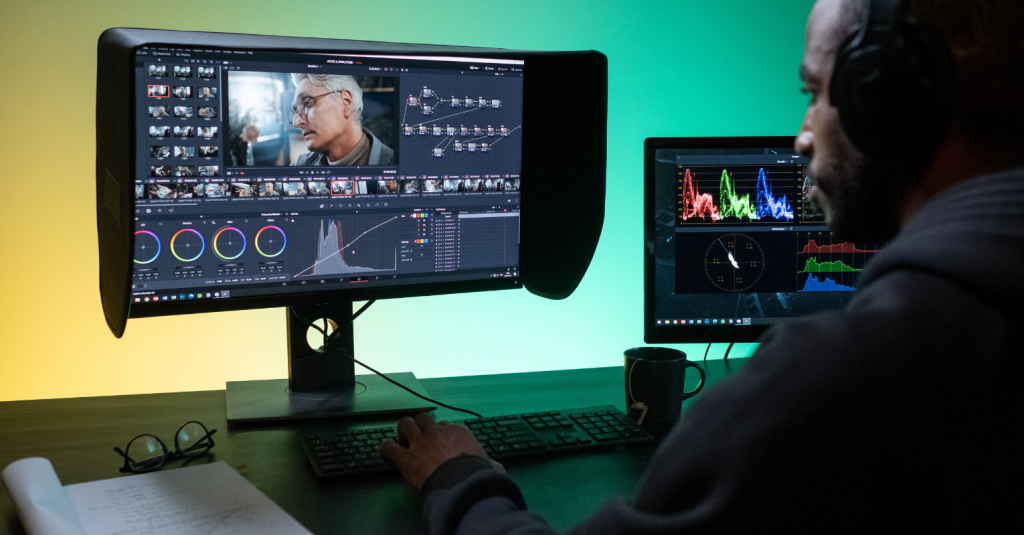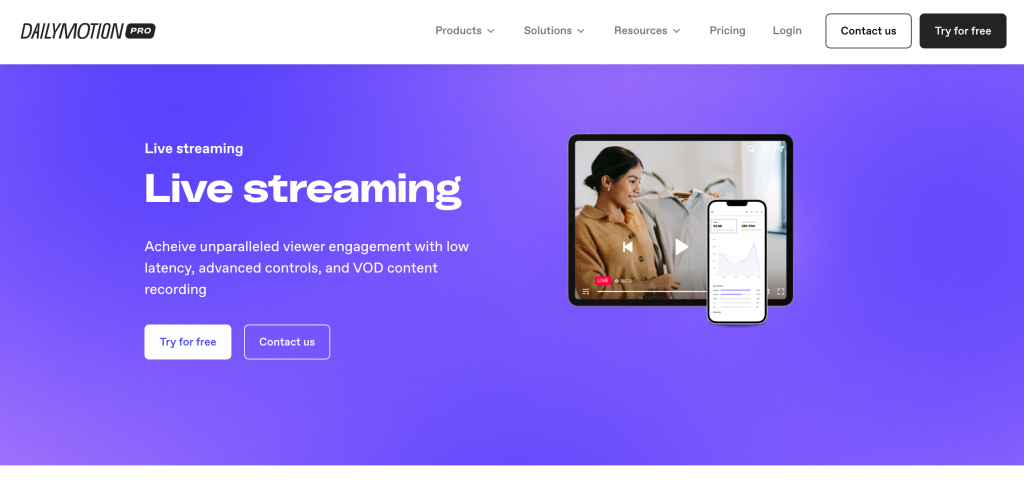Live Stream Encoding: How It Works and Why It Matters
Live streaming is a powerful way to share information and content with your audience in real-time. But do you know what makes live streaming possible?
Aside from cameras, microphones, computers, and strong Internet connections, people often overlook live stream encoders and are unaware of their importance in the field of live video streaming. Encoders play a key role in converting audio and video data into a digital format suitable for transmission over the Internet. This step is crucial because it directly affects the quality and consistency of the live stream.
In this post, we will look at what is live stream encoding, what a live stream encoder is, how it works, and why it is important for businesses. Read now to learn more useful information!
What is a Live Stream Encoder?
Live streaming is a time-sensitive process that requires an encoder capable of processing the video feed in real-time. An encoder is a tool that converts video content into a different format, creating a digital copy of your video source that can be transmitted over the internet.
The purpose of encoding a video is to reduce file size without affecting video quality. This process involves converting video and audio into a digital format that can be streamed online in real-time. Once the video is encoded, it can be embedded or streamed live right on your website. The data will be encoded into a format for streaming and sent to the streaming platform for distribution.
Live streaming is a complex process that requires proper encoding to ensure a smooth viewing experience for your audience. Without proper encoding, your live stream may stutter, lag, or have low video and audio quality, leading to frustration and reduced viewer enjoyment. To avoid this, live stream encoder often comes with tools that encode video formats in real-time, working with a variety of streaming protocols such as Real-Time Messaging Protocol or HTTP Live Streaming. These tools help ensure compatibility across multiple devices, such as smartphones, tablets, and computers, maximizing your reach and engagement.
Moreover, live stream encoding plays an important role in reducing bandwidth usage. Compressing data greatly reduces the amount of data transmitted during live streaming, making the process more efficient and cost-effective, especially when handling large audiences or limited network resources. Bandwidth optimization tools such as adaptive bitrate streaming tools adjust the quality of the video according to the network conditions, further reducing bandwidth usage.
In addition to encoding and bandwidth optimization tools, some tools are built to enhance live stream connection to streaming platforms like Dailymotion, YouTube Live, or Twitch, allowing you to broadcast your live stream to a large audience. These tools allow your viewers to access your live stream, regardless of their location, the device, or the network conditions they are using.
There are 2 main types of live-stream encoding:
- Software-based encoding: These are applications or programs that can run on your computer, laptop, or mobile device. This encoder converts the audio and video feed into a digital format for live streaming. This method is often preferred for its flexibility and cost-effectiveness, but it may require more CPU power and memory
- Hardware-based encoding: These are devices that are independent of your computer. They are dedicated to encoding live streams, so they often offer better performance and reliability. Hardware encoders are more suitable for professional live-streaming setups, but they may be more expensive and less versatile

How does Live Stream Encoding work?
Video encoding is a complex process that involves trade-offs between quality, file size, and computational complexity.
Capture the Video Source
The live stream begins with capturing the video feed from a source, such as a webcam, camera, or professional video equipment. This video needs to be transformed so it can be sent over the internet. Therefore, we use special technologies to convert the video format, from the original to a suitable format that can be transmitted over the network (such as MP4, AVI, MPEG1/2/4, WMV, 3GP, H.264, DVDs, and VCDs).
Converting the video format isn’t required and depends on the video’s source and destination. For instance, if the source is a webcam producing H.264 video and the destination is a web browser with H.264 playback support, there’s no necessity to change the video format. Yet, certain sources might demand transcoding, including one encoded video format converted into another.
However, the video will be encoded and edited to match how the internet transmits data but still retain its quality and clarity. We can receive high-quality video, which can be transmitted effectively on the Internet. This benefits viewers by providing a smoother and clearer video viewing experience.
Segmenting
After being captured and encoded into the right video format, the continuous video stream is divided into smaller segments, typically a few seconds in length. This segmentation is done by a streaming protocol like HTTP Live Streaming (HLS) or Dynamic Adaptive Streaming over HTTP (DASH).
Splitting the video stream creates short video segments, each of which can be encoded at different quality levels. This allows for more adaptive bitrate data transmission, as each segment can be encoded at a different quality to suit specific network conditions.
Users can enjoy a more flexible video viewing experience by splitting and encoding video segments. It helps adjust video quality according to current network conditions, ensuring that viewers can watch videos smoothly and without interruption.
Video encoding and segmentation aren’t strictly sequential processes; they can occur concurrently or in tandem. Certain encoders, for instance, can generate multiple segments of varied quality simultaneously. This approach can effectively cut down on encoding delays and lessen the amount of bandwidth used.
Video Encoding
Video encoding is intricate and involves a lossy process, where some information gets unavoidably trimmed during compression. This trimming can significantly impact the video quality, particularly if the compression ratio is excessive or the encoding settings aren’t optimized.
The segmented video data is then encoded using a video codec, such as H.264 (also known as AVC), H.265 (HEVC), VP9, or AV1. Video encoding involves compressing the video data by removing redundant information and optimizing the representation of visual elements.
The result of video encoding is a compressed version of the video, we reduce the size of the video while preserving its quality. Unnecessary information is removed to make the video more compact and easier to transmit over the network.
After encoding, the compressed video will consume less bandwidth and be easier to watch on devices with no strong internet connection. This creates a smoother video viewing experience and helps save space when watching videos online.
Audio Encoding
In addition to video, the audio accompanying the live stream is also encoded. Audio encoding technology may include compression algorithms such as AAC, MP3, or other encoding methods to reduce data size while maintaining audio quality.
However, audio encoding isn’t always handled independently from video encoding. Certain video codecs like H.264 and H.265 can encode audio data as well. Additionally, some streaming protocols like HLS and DASH can transmit both video and audio segments within a single stream.
The audio will be encoded and compressed, but the sound quality still be good without losing synchronization with the video. The audio data is modified so that it can be transmitted over the internet efficiently. This enables users to experience quality sound while watching a live video stream. Compressing audio data helps optimize communication over the Internet while preserving sound quality.
Compression and Bitrate Control
Compression and bitrate control aren’t just part of the encoding phase; they are also actively managed during streaming. The encoder can dynamically tweak these settings, relying on input from the streaming server or client. This adaptive approach fine-tunes the live stream’s quality and performance for an optimized viewing experience.
The result of this process is that the video has been compressed and the bitrate adjusted, it has been changed to reduce the file size or optimize the bandwidth required for transmission while retaining the desired level of quality. Therefore users get a balance between video quality and transmission performance. They can watch videos in good quality, while still saving network bandwidth, providing a smoother and clearer video viewing experience.
Distribution via Content Delivery Network (CDN)
The encoded video and audio segments are then distributed using a Content Delivery Network (CDN). A CDN consists of geographically distributed servers that help deliver the segments efficiently to viewers by minimizing latency and optimizing network routes. The CDN ensures that viewers can easily access the live stream across different locations.
This process helps efficiently distribute encrypted video and audio to viewers everywhere quickly and stably. Thanks to the CDN system with distributed servers, video is transmitted without delay and ensures stable quality. Using CDN, users can access the live stream easily and quickly anywhere. This creates a smooth video viewing experience, without lag or loss of quality while minimizing viewer wait time.
Playback
Viewers access the live stream by connecting to the CDN server closest to their location. The video player on their device requests the video segments from the CDN, which delivers them in response. The player then decodes and plays back the segments, providing a seamless viewing experience to the audience.
Viewers can watch the live stream seamlessly. Video segments requested and sent from the CDN server are decoded and played back without interruption, creating a live video viewing experience. Besides, users can conveniently view content and grasp information quickly in real time, without waiting long or encountering obstacles when watching live video.

Why does Live Stream Encoding matter?
Live stream encoding is a crucial aspect of delivering high-quality and reliable live video streams to viewers. This process is essential for several reasons:
Adaptive Bitrate Streaming
Adaptive Bitrate Streaming is a technique that allows the streaming platform to adjust video quality in real-time based on the viewer’s device and internet connectivity. This means that regardless of whether someone is watching the stream on a high-speed Internet connection or a slower mobile network, they will still have a seamless viewing experience.
This ensures that viewers can watch the live stream without interruption or buffering, resulting in higher viewer engagement and satisfaction. When viewers experience buffering issues, they may skip the broadcast, leading to a loss of viewership and potential revenue.
Transmission Efficiency
The video once converted will use less internet capacity when viewed on your device. It helps websites and online services play videos more smoothly, avoiding lag caused by large data loads over the internet. This will improve the video viewing experience, especially for people with low internet speed, they can still watch videos in stable quality without having to wait for long loading times. To achieve this, the encoder compresses video data by removing redundant or irrelevant information and optimizing the presentation of visual elements. Some examples of encoding standards commonly used for streaming are H.264, H.265, VP9, and AV1. The encoder can also dynamically adjust bitrate and compression settings, based on feedback from the streaming server or client to optimize the quality and performance of the live stream.
Devices Compatibility
Different devices have varying capabilities for processing and displaying video content. Encoding ensures that videos are played back effectively on a variety of devices and platforms. Video is encoded following publicly known standards that various devices and platforms can interpret. Some examples of devices and platforms that can play encoded video are smartphones, tablets, computers, TVs, and online platforms. However, some devices and platforms may have specific requirements or preferences for encoding formats, and transcoding may be needed to convert one encoded format to another. Viewers don’t need to worry about whether the video is compatible with their device. They can watch videos on any device without losing quality or viewing experience.

How To Choose The Right Encoding Settings For Your Live Stream
Choosing the right encoding settings for your live stream is important to ensure a seamless and high-quality viewing experience for your audience. You should consider making informed decisions to optimize your live stream.
First, you need to evaluate your available bandwidth. This refers to your internet capacity to upload your live stream. The higher your bandwidth, the better quality you can achieve. If you have limited bandwidth, you need to reduce the resolution or bitrate of your stream to avoid buffering or drops.
Next, look at the nature of your content and your target audience. If you’re streaming fast-paced action like a sporting event or game, a higher frame rate is essential to capture the fluidity of movement. On the other hand, if you’re streaming a lecture or webinar, just use a lower frame rate.
Resolution is another essential aspect to consider. High resolutions, such as 1080p or even 4K, provide a more detailed and vivid viewing experience. However, higher resolution requires more bandwidth and processing power. If your audience is primarily accessing your live stream on mobile devices or has limited internet connectivity, choosing a lower resolution may be more practical.
Furthermore, bitrate plays an important role in the quality of your live stream. It determines the amount of data transferred per second and affects both video and audio quality. Higher bit rates provide better image clarity and audio fidelity, but they also require more bandwidth. You need to find the right balance between your quality and accessibility.
Finally, don’t forget to consider the capabilities of your encryption hardware or software. Make sure that the selected encryption settings are compatible with your device and that you have the necessary resources to handle encryption efficiently.
Additionally, if you want to know about the best livestream encoders today, you can refer to this blog Top 15 Live Streaming Encoders (Hardware & Software) in 2023

Live Stream Encoding With Dailymotion
Dailymotion for Enterprises provides the most reputable live-stream encoding today. Dailymotion’s live stream encoding service brings users many outstanding features and functionalities, creating a more convenient, optimized video experience.
- Stream live video in 4K UHD: Stream content seamlessly from desktop or mobile so your audience can enjoy live events with great fluidity, minimizing lag, and allowing for real-time engagement.
- Live streams into VOD: Easily transform your live stream into VOD content, broaden your audience, and boost engagement. Extract and publish short highlights from your live stream as VOD content, effectively enhancing the value of your content.
- Live stream analytics: Monitor your live stream in real-time with our live dashboard, providing insights into audience behavior, engagement metrics, and other important analytics. Use this data to refine and optimize your live streaming strategy for better performance.
- A backup secondary stream: Our video player solution allows you to set up a primary live video stream along with a secondary backup stream. This ensures a seamless viewing experience for your audience, minimizing interruptions and maintaining smooth playback throughout.
- A dedicated support team: Our dedicated support team is on hand to quickly resolve any issues that may arise during your live stream, ensuring your stream is stable and your viewers have a great experience.
Here concludes our blog on Live Stream Encoding: How It Works and Why It Matters. The article provides information about what live stream encoding is, how it works, and why it is important for businesses. Live stream encoders are extremely important and indispensable in live video streaming, helping you have a smoother and easier viewing experience.
With Dailymotion, we offer a comprehensive suite of live-streaming solutions, featuring 4K UHD streaming, VOD conversion, live analytics, backup streams, and dedicated support. With these robust features, it guarantees a seamless, high-quality streaming experience for audiences.
For an even more extensive experience, explore all of Dailymotion’s feature options based on your plan here.
